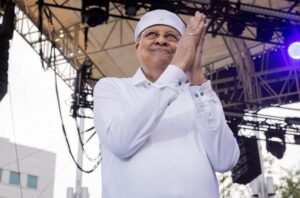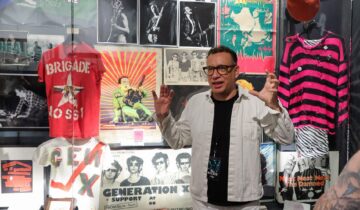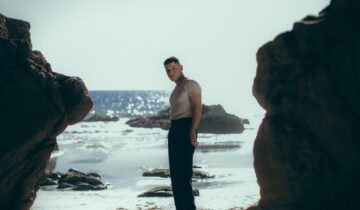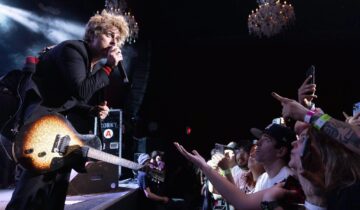 For Grammy.com PHOTO: TAKEHIKO TOKIWA
For Grammy.com PHOTO: TAKEHIKO TOKIWA
By Gary Moskowitz
Chucho Valdés recently returned to Jazz at Lincoln Center to perform his new four-part suite, “The Creation,” which incorporates elements of Santería ritual music, West African music, the blues, and “an atmosphere in the style of Miles Davis’ ‘Bitches Brew.'”
The Cuban pianist, bandleader, composer, and arranger Chucho Valdés seems to have a permanent smile on his face. He smiles when he plays something he likes on the piano, or when a bandmate surprises him with a tasteful note or phrase onstage. His eyebrows raise up in amusement when he begins an expressive piano piece, or when he’s asked interview questions he likes.
Valdés, who turns 81 this month, founded the iconic Cuban jazz group Irakere — which featured artists like Arturo Sandoval and Paquito D’Rivera — in the 1970s. He’s released seven albums on the Blue Note jazz label. His father, Bebo, was the pianist and director of the Tropicana Club orchestra and Orquesta Sabor de Cuba, and his son Chuchito also plays piano.
Valdés and the Yoruban Orchestra have been performing his latest four-part suite, “The Creation,” throughout the U.S. — including last week at New York City’s Jazz at Lincoln Center.
When GRAMMY.com sat down to chat over Zoom from Miami about the new suite, he wore his signature Kangol hat turned backwards, and smiled and laughed often. He mostly spoke in Spanish while his nephew translated, and occasionally broke off into English mid-way through responses.
Your new four-movement suite explores the story of creation according to La Regla De Ocha, the Yoruba-descended religion typically called Santeria. Why was it important to you to explore the creation story?
I’ve been studying the roots of the Yoruban story for a long time, and the influence of it on the people of the Caribbean. First of all, it’s my roots. My family is of Yoruban descent, so it’s a part of our identity. I want to save the history and the instruments and the language of our culture.
Your “Creation” suite incorporates elements of Santería ritual music, West African music, and the blues. Why did you want to combine those three specific elements?
African music and Latin music has so much to do with American music. All American music has an African influence, so I took all the elements of how this music was formed over time — especially the percussion, the melodies, and the singing. Music in the Caribbean and South America comes from the same roots, the African roots.
In what ways is Santeria significant or meaningful for you?
I am a Santero. It is my religion. In my family [there are ]a lot of Santeros, so we know all the history and everything. It is a belief in the Yoruba gods.
Everyone who likes Santeria is not necessarily a Santero. A Santero receives the Saints, and does a ceremony to get in. Primarily, it teaches you that when you’re a good person and you help people out, it comes back to you and it makes you feel happy, and that’s what I feel.
In what ways is this new suite different from your previous works?
I wrote a suite a long time ago called “The Black Mass,” a Yoruba mass. It’s the story of an African ritual with singing, and bata [a double-headed drum] touches. Every saint has a bata touch. It’s the instrument you use to communicate with the saints, and all the touches are different. Every touch tells a story.
“The Creation” explains how that music mixed with the Caribbean and how it evolved with the United States and the Blues. In between “The Black Mass” and “The Creation,” there have been other pieces, like one called “Juana 1600,” about the first name the Spanish gave to Cuba, and the year that slaves got sent to Cuba. It’s significant because that’s where I find a lot of where I come from and my identity.
You’ve described the suite as having “an atmosphere in the style of Miles Davis’ ‘Bitches Brew.'” How so? What about the “Bitches Brew” album inspires you?
I’m a huge fan of Miles Davis. I took the electronic elements of that album and put them in function of African rhythms to help it sound contemporary. This only happens in the first part, then it travels down different pathways. I just like the sonority, the sound that’s achieved. It inspires me to make Afro-Cuban fusion.
Let’s go back to the beginning for a minute. Growing up in Cuba in the ’40s and ’50s, what was your life like? What was your early exposure to music?
Growing up in that era in Cuba was very special for me because my dad was an icon in Cuban music and jazz. I got to see as a young kid all the musical stars from that era, from the US and Cuba, like Sara Vaughn, Nat King Cole, Roy Haines, Buddy Rich, Woody Herman, Stan Getz, and many piano players. All of this was a big influence in my life.
When did you start playing music? Was it always piano, or did you play other instruments as well?
My father used to say that when I was 3, I sat down at the piano and randomly started playing. I was way too young to remember.
The first time I remember playing live was when I was 9 years old. It was a classical concert at a theater. I played Mozart, Beethoven, and the music of my teacher at the time. I was very nervous that first time. Seeing the people in the audience scared me, but I played very well.
My father was a very good jazz piano player. Papa played like the bebop players. In the house he would play music like Wynton Kelly, Duke Ellington, Bud Powell, Thelonious Monk, and Glenn Miller.
You became a bandleader in the early 1960s. What were those early recording sessions like for you?
I directed a trio at first. It was very exciting for me because I actually liked it. I felt the things the way I heard them on records.
Then I upgraded from a trio and added a wind section. I wrote all the pieces, and it was exciting for me to listen to what I had written. To this day, I love to do it, and I’m still doing it.
What made you different from other bandleaders?
The style of music I was doing. I was doing a mix of Afro-Cuban and bebop. It was like an African Dizzy Gillespie. Dizzy was a real hero for me.
What was your relationship with Dizzy like?
I played with Dizzy in Cuba in 1977. It was one of the most important moments of my life. I felt very motivated by him. He was very inspirational. He was one of the creators of the language of bebop, a true pioneer. He influenced a lot of generations, and for me it was because of his musical vocabulary.
What do you think distinguishes the vocabulary of Cuban music from other types of music? What makes Cuban music genuinely “Cuban?”
Cuban music is very rich in rhythms, and any of them can be adapted to jazz. The most important part of Cuban music is the rhythm. It can be mixed even with symphonic music. There’s symphonic bands that use Cuban percussion instruments, and in jazz a lot. What Chano Pozo did with Dizzy, he added Afro-Cuban instruments to a big band, and that was the beginning of Afro-Cuban jazz.
You’ve won seven GRAMMY Awards and four Latin GRAMMYs. How did winning that very first GRAMMY make you feel?
When I won my first GRAMMY, I felt like I was dreaming. It made me feel like I have to keep doing better than before. It’s scary to think you could stop winning, so I try to keep making good music, especially different things from what I’ve already done.
Aside from those prestigious awards, what would you say is another one of your proudest musical accomplishments so far?
I’ve earned honorary doctorates in music from Berklee [College of Music] and universities in British Columbia in Canada, and also in Cuba. These awards are also very special to me.
You spend a lot of time teaching music to younger musicians. What is your style of teaching?
I like to teach a mix of jazz and Afro-Cuban music, but also a mix of classical and show how it relates to Cuban music or jazz. I like to explain how these things come together. Outside of music I also have a teaching degree, which helped me a lot.
How do you get young musicians to find their voice?
I’m very outgoing with my students. I study my students’ personalities and teach them according to how the students are as individuals. Not everybody is the same. I am very loving, but when I have to be very serious, I am.
Do you remember when or how you found your voice as a piano player? What’s the Chucho Valdes style or approach?
I found my voice when I was 22. Before I was 22, he was playing more like my dad than myself. But I started finding myself when I started listening to other pianists and getting more influences beyond my dad’s influences, like McCoy Tyner, Bill Evans, Keith Jarrett, Chick Corea, and Herbie Hancock. Then I started finding Chucho.
The first piece I wrote when I felt like I was playing like Chucho was “Mambo Influenciado,” and today that is a standard.
How do you describe your sound?
My sound is a mix of a lot of elements that converge as one. It’s very rhythmic, very poetic, and melodic. I can also play the piano as if it were drums. And I can play with the beauty of Chopin or Bill Evans. Chopin was incredible.
Looking ahead, what do you plan to focus on after these “Creation” suite performances?
I will focus on an Afro symphonic project I’ve been working on. It will be like [George] Gershwin mixed with African music. I’m working on that right now. I have a piece called Cuban Rhapsody, a great piece I wrote many years ago. Gershwin visited Cuba many times.
Gershwin’s “Rhapsody in Blue” is the United Airlines theme song, so maybe one day your “Cuban Rhapsody” will also be an airline theme song.
I hope so!



